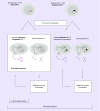HIV-1 latent reservoir: size matters
- PMID: 28757894
- PMCID: PMC5480782
- DOI: 10.2217/fvl-2016-0093
HIV-1 latent reservoir: size matters
Abstract
More than 35 million people remain infected with HIV-1. Upon antiretroviral therapy cessation, HIV-1-positive individuals systematically fail to achieve sustained virological remission, revealing the presence of a reservoir. This reservoir takes into account anatomical sanctuaries where HIV-1 continues to replicate, and latently infected cells also known as the latent reservoir (LR). A better understanding of the nature and features of the LR and its quantification are crucial to evaluate the efficiency of therapeutic strategies aiming at purging HIV-1. Culture- and PCR-based assays have already been implemented to measure the LR, and new assays are continuously being developed. In this review, we will discuss these methods highlighting the difficulties to accurately measure the LR, one main obstacle in curing HIV-1.
Keywords: DNA; HIV-1; RNA; assays; latent reservoir; quantification; size.
Conflict of interest statement
Financial & competing interests disclosure The authors have no relevant affiliations or financial involvement with any organization or entity with a financial interest in or financial conflict with the subject matter or materials discussed in the manuscript. This includes employment, consultancies, honoraria, stock ownership or options, expert testimony, grants or patents received or pending, or royalties. No writing assistance was utilized in the production of this manuscript.
Figures


References
-
- AIDS epidemic update: December 2007. UNAIDS, Geneva. http://data.unaids.org/pub/EPISlides/2007/2007_epiupdate_en.pdf
-
- Melkova Z, Shankaran P, Madlenakova M, Bodor J. Current views on HIV-1 latency, persistence, and cure. Folia Microbiol. 2016 Epub ahead of print. - PubMed
-
•• Describes mechanisms leading to HIV-1 latency.
LinkOut - more resources
Full Text Sources
Other Literature Sources
